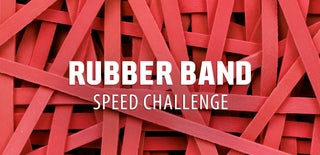Introduction: Bretz Labs Marble Maze
I saw a product like this in a STEM Catalog for $75. I looked at the pieces that made up this project and figured I had pretty much everything I needed as scrap at my house. If you had to buy all the materials, this should still be under $5 for materials. I like the concept of the device as it is ever changing and can be applied in many different ways. You could create challenges like a number of steps the marble has to travel through before it gets to the bottom, or you could put in obstacles that have to be overcome in order to reach the finish line.
Supplies
Materials Needed
-Peg Board
-Pegs
-Rubber Bands
-Marbles
-Scrap Wood for the Base
-Spray Paints or wood finishes.
Tools I Used
-Table Saw
-Chop Saw
-Palm Sander
Step 1: Gather Your Materials
I started with a 2' x 2' square of peg board that was left over from a previous project and a scrap of old oak that was about 6" wide by 12" long.
Step 2: Refine Your Materials
I took both materials to the table saw. I cut the peg board so that there would be a boarder all the way around it between the holes and the outside. I ripped the oak board down to about a 3 inch wide piece.
Step 3: Make the Base
I decided to go with a base that could be put together and taken down so it could be moved or stored when not in use. I started by finding the center height and length for both oak pieces. From there I drew lines to make a 5/8 gap to be cut out on my table saw. I clamped both pieces together so that the cuts would be the same for both pieces. I started by notching out the outsides of those cuts on the table saw. Once the outsides of the cut were established, I notched out the middle. You can see that when you flip one piece over, they fit together creating an X.
Step 4: Sand Everything Smooth.
I used my palm sander with an 80 grit pad to take off all of the old finish and paint from the oak base pieces. I then followed that up with 180 grit pad to smooth it all down. I also rounded off any sharp corners as this project will likely be used by younger children.
Step 5: NOTCH THE BASE FOR THE PEG BOARD
This was the step I thought the most about. Based on my design, I was thinking the board would be at a 30 degree angle, but my base was an X shape, so I decided to have the base put together while making the notch with the saw set at a 30 degree angle. There's probably a better and safer way to do this step, but this is what I came up with based on the tools at my disposal.
Step 6: ADD COLOR AND FINISHES
I wanted to use the brightest colors I had, but I didn't have a huge selection of rattle cans on hand at the moment. These are all leftover colors from other projects. I decided to go with a traditional stain for the oak base pieces because they are really nicely grained pieces of wood. If I decide I don't like it, I can always change this feature later. This would be another part where you could greatly modify everything to your taste or audience. One thing I thought of late was using chalkboard paint on the peg board so you could draw obstacles on it with chalk
Step 7: ASSEMBLE THE PRODUCT
Put the cross base together and slide the pegboard into the slot and the product is basically assembled.
Step 8: Cut the Pegs.
I used 1/4" dowel rod for my pegs. I cut them at 1 inch lengths on my bandsaw and then lightly sanded them with some 180 grit sandpaper.
Step 9: ADD PEGS AND RUBBER BANDS
At this point all we need to do is add pegs and rubber bands. This is the part I like about the project. There is so much ability to modify and for students/kids to create with this project. With a chalk board paint background you could draw the obstacles on the board, but you could also take scrap blocks and hot glue pegs to them to create obstacles as well. This is a course my son came up with in about 10 minutes.

Participated in the
Rubber Band Speed Challenge









